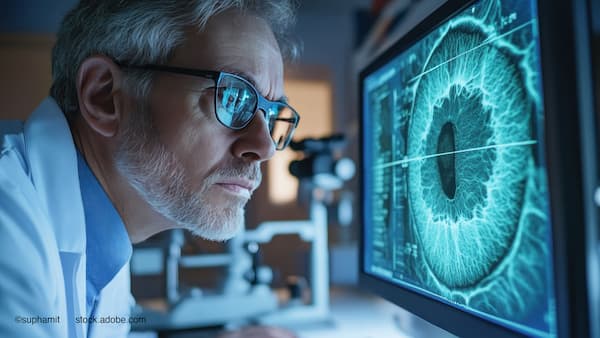News
Article
AI, big data, and personalized medicine: Scientists reveal playbook designed to revolutionize healthcare
Author(s):
Key Takeaways
- Precision medicine, utilizing big data and AI, aims to deliver personalized treatments by understanding genetic and molecular disease mechanisms.
- COVID-19 highlighted the necessity of interdisciplinary collaboration and digital tools in healthcare innovation and public health management.
The COVID-19 pandemic changed medicine forever, and now scientists are forging a new path for healthcare in the future, including in ophthalmology.
International researchers envision precision healthcare using revolutionary technologies and interdisciplinary collaborations for future delivery. (Image Credit: AdobeStock/Production Perig)

How will healthcare be delivered in the future? A team of international researchers hopes to answer this question by detailing a vision for precision approaches to understanding, preventing, and treating diseases, driven by revolutionary technologies and new interdisciplinary collaborations between researchers and other health sector professionals.
The scientists detailed their vision in a recent report published in Frontiers in Science.1
The team of researchers, led by Michael Goldman, PhD, recipient of the Blaise Pascal Medal 2024 for his contributions to immunology and healthcare innovation, and leading microbiologist Prof Philippe Sansonetti, MD, MS, from the Institut Pasteur and Collège de France – build on the many lessons of COVID-19, from strategies for radically faster vaccine development to use of big data and digital medicine.
“The COVID-19 pandemic will have profound, long-lasting impacts on the anticipation of risk, practice of medicine, and the management of healthcare,” Goldman, who is president and founder of the Institute for Interdisciplinary Innovation in Healthcare (I3H) at the Université Libre de Bruxelles and former Executive Director of the Innovative Medicines Initiative (IMI), said in a news release.“It demonstrated the importance of collaboration across sectors and disciplines to develop new solutions for major public health threats, and the power of artificial intelligence (AI) and digital tools for the advancement of medicine.”
Changing the paradigm
To combat the COVID-19 pandemic, the world needed to take a radically different approach to care – and scientists innovated to make this happen. According to the news release, 9% more health-related articles were published worldwide than expected from 2020 to 2022, reflecting scientists’ search for tools to solve the problems of the pandemic, which ultimately went far beyond the treatment of infectious diseases.2
With no vaccines available initially to control the transmission of the virus, the public needed non-pharmaceutical interventions like lockdowns. Video ensured patients could speak to a doctor without risking catching the virus, while insights from big data were used to identify vulnerable patients and target treatments. Goldman and his colleagues pointed out in the study that these are innovations in medicine – personalized, taking advantage of big data and new technology – that likely will be used to design the future of healthcare and public health.1
“Personalized medicine delivers the right treatment to the right patient at the right time,” Sansonetti said in the news release. “It will depend on in-depth characterization of both the genetic make-up of the affected individual and the molecular mechanisms of the disease. A patient’s way of life and environment will also be taken into consideration.”
Systems medicine could also enable more effective care: it “exploits large quantities of different kinds of data, gathered through different sources, to generate highly precise diagnosis, prognosis, and therapeutic options,” explained Sansonetti. For instance, it could help identify pre-existing drugs which we already know are safe that can be quickly repurposed to treat new diseases.2
The sciences have also found that digital health also can take medicine to the individual. Telehealth can make it easier for patients to consult with a medical professional, while wearable monitors allow for at-home management of some conditions, which is associated with better outcomes.
A roadmap for healthcare
However, the scientists stress that a lot of work remains to be able to make this vision a reality. The necessary conditions for this medicine of the future are not equally available globally. For instance, in some places, the technology for digital health or the tests necessary for personalized medicine are less available. For systems medicine to work effectively and safely, AI applications need to be more transparent and must be carefully managed to ensure patient privacy and to avoid bias.
The team also noted that a framework for funding and research that supports the kind of interdisciplinary work that drove innovation during the pandemic needs to be created in the post-pandemic era. Goldman and colleagues lay out what this could look like, and what should be tackled first.
“The greatest likely challenges of the future, antimicrobial resistance and zoonotic illnesses that jump from animals to humans will need to be addressed by scientists and clinicians from many disciplines working together,” the researchers noted in the news release. “We need to enable this cooperation now, by encouraging interdisciplinary studies and collaboration, to build healthcare that can overcome these future challenges.”
“As we navigate the complexities of the post-Covid era, we must foster multidisciplinary collaborations that transcend traditional boundaries, encompassing molecular, clinical, and social determinants of health,” Giuseppe Remuzzi, PhD, director of the Istituto di Ricerche Farmacologiche Mario Negri and senior author of an editorial commentary on the article, concluded in the news release. “This very timely article is a statement of intent – a testament to the resilience and adaptability of science to address forthcoming public health challenges.”
AI in ophthalmology
AI has also been making inroads into ophthalmology. Last year, The Icahn School of Medicine at Mount Sinai opened the Center for Ophthalmic Artificial Intelligence and Human Health, which is dedicated to advancing AI to offer faster diagnosis and treatment.
According to a news release from Mount Sinai,3 the center is the first of its kind in New York, and strives to reshape patient care by creating more timely diagnosis of eye disease and innovative risk assessment of systemic health conditions.
Mount Sinai noted in the release it would be incorporating AI into trainee and physician education, research, and the clinical setting for prompt diagnosis of eye diseases and conditions. Some of the eye diseases targeted for prompt diagnosis include macular degeneration, diabetic retinopathy, glaucoma, hypertensive retinopathy, systemic conditions, and retinal tumors.
Mount Sinai stressed the importance of quick diagnosis in the press release. “Early detection and intervention can prevent vision loss, and may also prevent heart attack and stroke, since several eye conditions are linked to cardiovascular and neurological issues.”
In a conversation with Ophthalmology Times earlier this year, Kathryn A. Colby, MD, PhD, Elisabeth J. Cohen Professor and Chair, NYU Langone Department of Ophthalmology, noted that telemedicine and AI would be front and center in the coming years.
“We have to be mindful about how we incorporate these not only into our clinical care but into our training,” she said in a video interview.
AI in research
A team of researchers at the National Institutes of Health have applied AI to a technique that produces high-resolution images of cells in the eye, which ultimately could speed the imaging process for ophthalmologists.
The researchers have found that using AI, imaging is 100 times faster and improves image contrast 3.5-fold. The advance, according to researchers, will provide them with a better tool to evaluate age-related macular degeneration (AMD) and other retinal diseases.
“Artificial intelligence helps overcome a key limitation of imaging cells in the retina, which is time,” said Johnny Tam, Ph., leader of the Clinical and Translational Imaging Section at NIH's National Eye Institute.4
In other work, a Johns Hopkins Children’s Center study of children and youth with diabetes concludes that autonomous AI diabetic eye exams significantly increase completion rates of screenings designed to prevent potentially blinding diabetes eye diseases (DED).
According to a Johns Hopkins news release,5 during the exam, pictures are taken of the backs of the eyes without the need to dilate them, and AI is used to provide an immediate result.
The researchers found, according to the news release, that the AI-driven technology used in the exams may close “care gaps” among racial and ethnic minority youth with diabetes, populations with historically higher rates of DED and less access to or adherence with regular screening for eye damage.
A quartet of presentations at the Association for Research in Vision and Ophthalmology’s (ARVO) 2024 Annual Meeting in Seattle, Washington, demonstrated the expansion of AI in ophthalmology.
According to a news release, the presentations demonstrated the benefits of involving AI in vision research and global health. They showed the advantages of having AI systems to support scientists, clinics and patients.6
References:
- Michael Goldman; Simon Cauchemez, Giulio CossuS, Alain Fischer. et.al. Standing the test of COVID-19; Charting the new frontiers of Medicine. Front. Sci., 22 May 2024 Volume 2 - 2024 | https://doi.org/10.3389/fsci.2024.1236919
Big data, AI, and personalized medicine: scientists reveal playbook aiming to revolutionize healthcare. EurekAlert! Accessed May 29, 2024. https://www.eurekalert.org/news-releases/1044972
Mount Sinai Health System. Mount Sinai Launches Center for Ophthalmic Artificial Intelligence and human health. Mount Sinai Health System. Press release. July 5, 2023. Accessed July 5, 2023. https://www.mountsinai.org/about/newsroom/2023/mount-sinai-launches-center-for-ophthalmic-artificial-intelligence-and-human-health
AI makes retinal imaging 100 times faster, compared to manual method. National Institutes of Health (NIH). Published April 10, 2024. Accessed April 10, 2024. https://www.nih.gov/news-events/news-releases/ai-makes-retinal-imaging-100-times-faster-compared-manual-method
Study finds AI-driven eye exams increase screening rates for youth with diabetes. EurekAlert! Accessed January 12, 2024. https://www.eurekalert.org/news-releases/1030941
The Association for Research in Vision and Ophthalmology-. www.arvo.org. Accessed May 7, 2024. https://www.arvo.org/About/press-room/press-room/innovative-artificial-intelligence-tools-in-ophthalmology/
Newsletter
Don’t miss out—get Ophthalmology Times updates on the latest clinical advancements and expert interviews, straight to your inbox.





